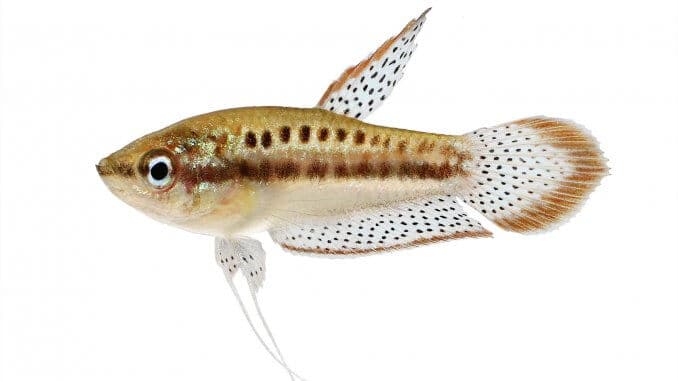
Sparkling gouramis are freshwater fish that are part of the gourami family. These fish are native to Southeast Asia.
The sparkling gourami is a fish that’s rarely found in home aquariums, which makes it special and unique.
Their beautiful scales, colors, and compatibility make it a great choice for people looking to add a pinch of originality into their tank.
TABLE OF CONTENTS
Sparkling Gourami Facts & Overview
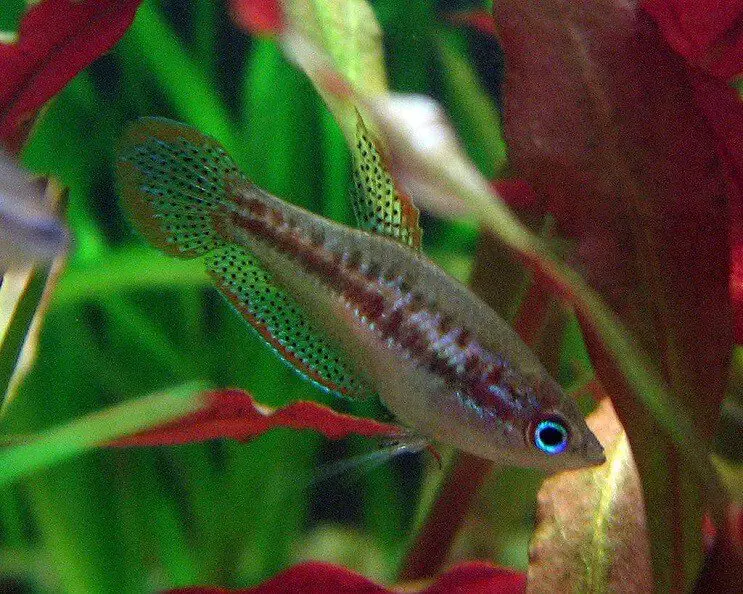
| Category | Rating |
| Care Level: | Easy |
| Temperament: | Relatively peaceful |
| Color: | Dark with bright spots |
| Lifespan: | 4-5 years |
| Size: | Up to 1.6 inches |
| Diet: | Omnivore |
| Family: | Osphronemidae |
| Minimum Tank Size: | 15 gallons |
| Tank Setup: | Freshwater (planted) |
| Compatibility: | Limited |
The Sparkling Gourami (Trichopsis pumila), also known as Pygmy Gourami, is a small freshwater fish native to the ponds, slow rivers, and rice fields of Southeast Asia. It is a member of the Osphronemidae family and the Anabantiformes order.
These Gouramis are very small and usually live up to 5 years. However, in good aquarium conditions, they may sometimes live longer.
They belong to the anabantiformes order – also known as labyrinth fish.
Fish in this group have a special labyrinth breathing organ that allows them to take in oxygen straight from the air, instead of the way most fish get oxygen which is dissolved in the surrounding water.
Their price heavily depends on health, overall condition, and where you’re buying from. Healthy 1-inch Gouramis usually sell for $2. Keep in mind that most stores usually have discounts when you buy multiple fish together or in pairs.
Typical Behavior
Sparkling Gouramis are not schooling fish but they still prefer to be in groups of five or six.
They are quite peaceful but sometimes can be aggressive towards other males. They are very competitive when it comes to having their own territory.
An interesting behavior you will see is them breathing. You will see them swim up to the water surface and breathe using their labyrinth organ. Such behavior is seen only in adults, because young fish use their lungs while the labyrinth organ develops.
Surprisingly, these fish do not have a preferred layer of tank and can be found swimming all over.
Their unique breathing behavior forces them to often swim near the upper level. Sparkling Gouramis also enjoy spending time looking for hiding spots or swimming through plants.
This fish is also unique because it makes sounds! They make an almost croaking/chirping sound which can be heard from outside the tank, when they are happy or are mating.
Appearance
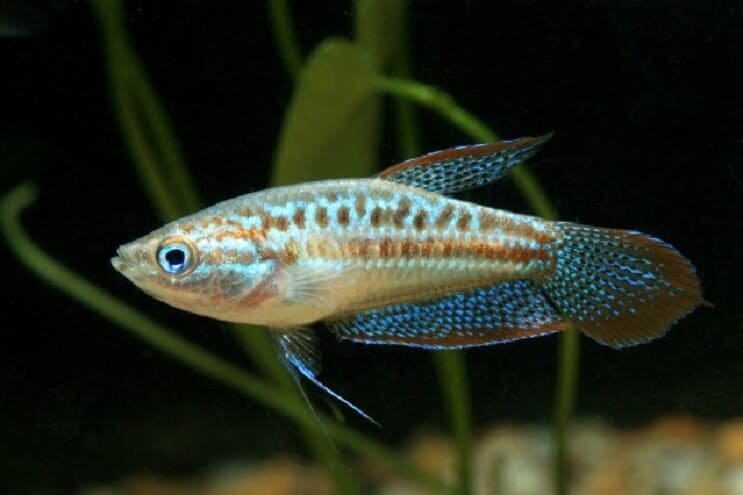
Their body is elongated, compressed on the sides and towards the end.
These are very small fish, whose fins are about 30% of their body length. They have a standing dorsal fin and a wide merged anal fin. Their pelvic fin is small and has a long threadlike outgrowth. Their eyes are quite big and blue colored with a unique rim.
Sparkling Gourami are typically a brown color. However, small colorful spots that are found all over their scales create green, bluish, grey or sometimes white coloring across the body. The bottom part of their head and abdomen is significantly lighter than the rest of the body.
All their fins usually have a brown or dark orange edging.
Each fish will have a unique color pattern, ranging from well-organized black lines to sporadic small light blue dots all over its body. So even though they’re the same species, they will look unique!
Their fins have black dots on a light blue background. All these colors combined with the structure of their scales beautifully reflect light, making it seem like the fish is sparkling.
Habitat and Tank Conditions

Sparkling Gouramis are found all over Southeast Asia in ditches, slow rivers, small ponds, and even rice fields. They prefer slow-flowing water with lots of plants on the river bed.
Their unique lung-like organ lets them live in a range of different environments, including poorly oxygenated waters.
This natural habitat will usually have a variety of different plants and all sorts of hiding spots.
Fortunately, their natural environment is fairly easy to replicate in the tank.
Tank Setup
Sparkling Gouramis look best against a dark substrate; this contrast will enhance the visual sparkles of these beautiful fish. You can use any substrate you like, just make sure it’s appropriate for freshwater aquariums and small fish.
You should aim to keep the temperature around 77°F (acceptable range 71.5–80.5°F). Water hardness should be kept in the range of 5–18 and pH should be 6–8.
As for the lighting, bear in mind their love for plants. The lamp in your tank will be needed by the fish and all greenery. Keeping it switched on for around 9-10 hours will be enough.
Sparkling Gouramis prefer a slow water flow and can live in a poorly oxygenated environment. They do not like rapid water flow, so make sure to use a low-powered filter.
Highly oxygenated waters are not particularly important for these species. This means that you don’t need a very powerful aeration system.
Remember that they really enjoy hiding and plants. Having a lot of plants, with some floating ones, and various decorations is ideal. This will give them lots of space to explore and is guaranteed to make them happy.
What Size Aquarium Do They Need?
Due to their small size, Sparkling Gourami needs a 15-gallon tank.
For every additional Gourami in the tank, add 10 gallons to this figure.
Tank Mates
Due to how small they are, Sparkling Gouramis should only be kept with non-aggressive tankmates of roughly the same size. Keeping them with relatively small fast swimmers is not recommended, as very active fish tend to nip their fins.
Male Bettas are not the best neighbors either, because of their similar appearance Bettas often get confused and will attack Gouramis.
It is best to keep Sparkling Gouramis together or with small non-conflicting fish. For example, you might consider Dwarf and Pearl Gouramis, Rasboras or Neon Rainbowfish.
Some other fish that make good tank mates are Corydoras, Tetras, or Otos.
As mentioned before, male Bettas, Black Tetras, and Tiger Barbs are not the best choice and should be avoided.
If you wish to keep something other than fish, bear the same points in mind. They should be peaceful and not very large. Otherwise, conflicts are bound to happen.
Some crustaceans to consider include ghost shrimp and nerite snails.
Keeping Sparkling Gourami Together
Remember males tend to compete with other males for territory and attention, so it is recommended to keep one male with around 3-4 females.
Diet
In the wild, they usually feed on small insects that either fall into the water or live in it. However, in the tank, they will gladly feed on dry and live foods. Sparkling Gouramis can also be fed flakes foods.
Their diet should include meaty live and frozen foods, such as daphnia, artemia, bloodworms, or shrimp meat. Maintaining a diverse diet is especially important for these species, as they rarely graze on aquarium plants and most “leafy” nutrients come from combined foods.
Live foods help Sparkling Gouramis reach their best in terms of size and appearance. So, having a varied and consistent feeding pattern is beneficial both for you as an aquarist and the health of your fish.
As well as live and frozen food, you can also feed them freeze-dried foods.
If your fish appear quiet at any time, there is probably something wrong with consistency or the food itself. There are various supplements available to increase the nutritional quality of the food.
Where possible always use high-quality food that is high in protein.
Care
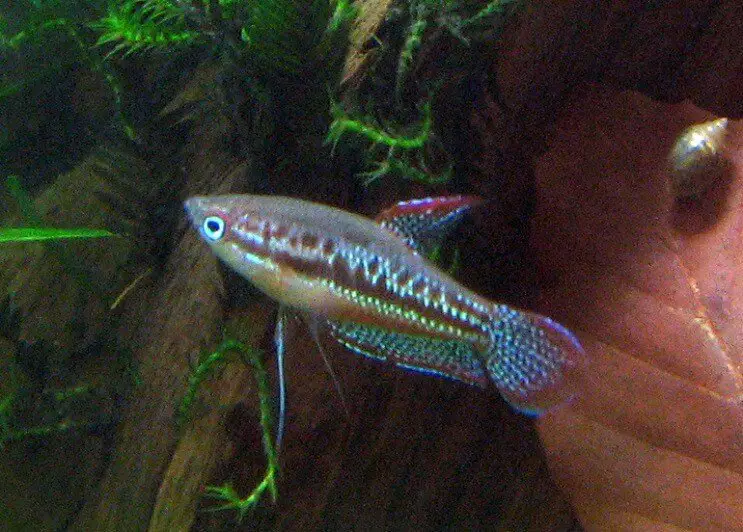
Sparkling Gouramis are hardy fish that do not require lots of care.
The water parameters should be kept in the range we mentioned above and the levels should be monitored closely. Weekly water changes of 25% are also needed.
This species is easily scared by loud noises or fast water flow. So placing your aquarium in a quiet place is a good choice.
Their love for hiding all over the tank has already been mentioned. If there aren’t enough plants in your aquarium, the fish will become stressed. When fish are stressed there is a chance that they will jump out of the tank.
Try placing some decorations in various places. That will not only allow you to personalize the tank but will also provide additional spaces to explore.
Sparkling Gouramis are not prone to any disease, but it is useful to keep an eye out for any signs of sickness. For instance, one of the most common diseases with freshwater aquarium fish is the white spot disease (Ichthyophthiriosis).
It can be recognized by the appearance of many white spots all over your fish.
If you suspect that your fish have been contaminated, get medication to control the disease as soon as possible. If no measures are taken, this condition is likely to be fatal for all fish in the tank.
Overfeeding is also a common problem with Gouramis. Again make sure you follow the guidance in the diet section above.
Breeding
Sparkling Gouramis can be bred at home, and it is fairly straightforward.
To make breeding as natural as possible, it’s best that you have around 6 fish in the tank and allow them some time to form pairs naturally. Alternatively, you can buy a couple of pairs. Just ensure that there are at least 2 females for each male.
Breeding can be stimulated by slightly increasing temperature, by 3-5°F and lowering the water level to about 6 inches. Sparkling Gouramis are not free spawning, which means the male will protect and look after fry.
Parents should be fed live meaty foods before breeding starts. You can also tell that fish are ready to breed by the slightly round abdomen in females.
Breeding starts when the male begins constructing a special nest using foam and saliva. In the wild, it’s then placed under a plant. You can replicate this by using big-leafed plants such as Anubias in your tank.
After the male has finished building the nest, he starts courting the female. Males playfully swim around them, straightening their fins, almost hugging the partner. This sometimes looks like the male is trying to squeeze eggs out of the female.
When spawning happens, the male fertilizes eggs, catches them, and puts them into the nest. This process can repeat several times during the day. With each spawning, the female releases about 15 eggs, but in the end there will be hundreds of fertilized eggs in the nest.
Females should then be moved to a separate tank right after spawning finishes. The male will stay in the tank until the fry hatch. After a few days, the fry will hatch, but they won’t leave the nest yet. As they grow, they will start swimming away from it. At that point, you can move the male into a separate tank.
The fry of Sparkling Gourami is very small and will initially feed on plankton and infusoria. As they become bigger, their diet will shift towards micro-worms and artemia.
Are Sparkling Gourami Suitable For Your Aquarium?
Sparkling Gouramis are one of the most beautiful species available. Their vivid appearance makes them a solid competitor for even the most colorful fish out there.
These sturdy Gouramis are easy to look after and can be great tank mates to a wide range of fish.
Remember, the aquarium should be heavily planted, with decorations and lots of hiding places. This gives you a chance to make it unique, creating your own little aquatic forest.
What do you like most about Sparkling Gourami? Let us know in the comments section below…

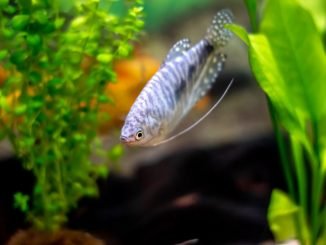
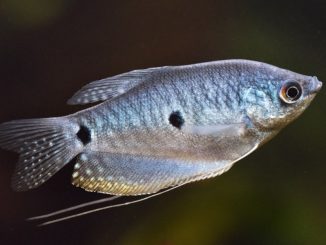
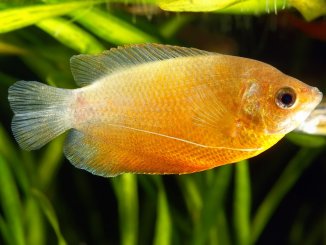
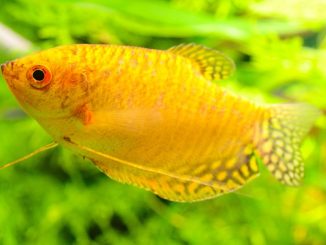
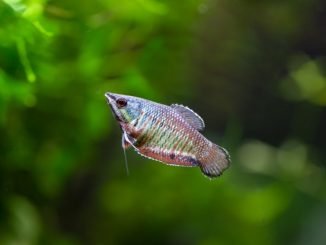
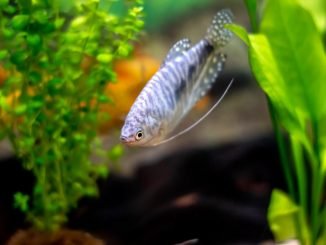
Thanks for letting me in on this beautiful fish. I would love to get one once I buy another aquarium. I never knew how much advice I could get on so many fish. Thanks for creating this site and the weekly newsletter, I greatly appreciate it!?
This a wonderful and very thorough article- undoubtedly very helpful to anyone considering these fish. I have a trio of the little guys and they’re some of the most fantastic fish I’ve kept. I was wondering if you had any advice on telling the males from the females?
Hi Zack, these fish can be difficult to sex until they’re mature, even then it’s a little tricky too. Mature males normally have a more intense colour pattern and longer ventral, anal, dorsal, and caudal fins than females. Hope that helps you determine who is who! Robert
My 9 year old son has just set up his first 15 gallon tank and has been looking for ideas for for stocking, he really wants some guppies but also wanted a dwarf gourami, but i have read that they may not be compatible as the gourami may attack the guppies, would the sparkling gourami be a better choice? if so can they live singly or would you need at least a pair? Or could you give any suggestions of tank mates for guppies
Hi Keren, the Pearl Gourami would make an ideal tank mate for guppies. They can live singularly or in a pair, the choice is up to you. Here is our article on Guppies where you’ll find plenty of tank mate suggestions: https://www.fishkeepingworld.com/guppies/ Thanks, Robert
Hi, I’m restocking my 20g and I’m wondering if this will work: 4-5 sparkling gouramis, 6-8 rummynose tetra, 4-5 otos, and maybe a trio of platies. Is this too much? Also, is just having dritwood and lots of plants in the tank enough, or should more decor be added? Thanks
id add an Oscar